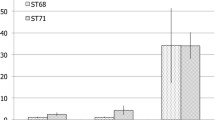Abstract
P. aeruginosa living in biofilm populations sends out diffusive signalling molecules, called autoinducers, for example acylated homoserine lactone (AHL) or the P. aeruginosa quinolone signal (PQS). So far, two quorum-sensing systems, LasR and VsmR, have been identified in P. aeruginosa, both of which are required for all virulence determinants. The expression of specific genes involved in quorum-sensing regulatory mechanisms has been analysed with molecular biology methods. Real-time quantitative PCR is a highly sensitive and powerful technique for quantification of nucleic acids. Expression of the genes vsmR, lasI, and PA4296 was studied by use of reverse transcriptase and subsequent quantitative real-time PCR of the cDNAs. In parallel, expression of ribosomal 16S rRNA, used as a housekeeping gene that was constitutively expressed in all analyses, was also monitored. Biofilm was compared with planktonic bacteria, and in contrast to vsmR and Pa4296, the lasI gene was found to be down-regulated in biofilm. Extended experiments were run with synthetic signal molecules inducing regulated processes in bacterial populations. It was shown that the genes under investigation were up-regulated in mature biofilm in the presence of the signal molecule N-(3-oxododecanoyl)-l-homoserine lactone.



Similar content being viewed by others
References
Freemann W, Walker S, Vrana K (1999) BioTechnique 26:112–125
Muller P, Janovjak H, Miserez A, Dobbie Z (2002) BioTechnique 32:155–161
Pfaffl M (2001) Nucleic Acids Res 29:129–136
Thellin O, Zorzi W, Lakaye B, DeBorman B, Coumans B, Hennen G, Grisar T, Igout A, Heinen E (1999) J Biotechnol 75:291–295
Hentzer M, Eberl L, Givskov M (2005) Biofilms 2:37–61
Hentzer M, Eberl L, Givskov M (eds) (2003) Microbial biofilms. ASM Press, Washington, DC
Stover C, Pham X, Erwin A, Mizoguchi S, Warrener P, Hickey M, Brinkman F, Hufnagle W, Kowalik D, Lagrou M, Garber R, Goltry L, Tolentino E, Westbrock-Wadman S, Yuan Y, Brody L, Coulter S, Folger K, Kas A, Larbig K, Lim R, Smith K, Spencer D, Wong G, Wu Z, Paulsen I, Reizer J, Saier M, Hancock R, Lory S, Olson M (2000) Nature 406:959–964
Diggle S, Winzer K, Latdunski A, Williams P, Cámara M (2002) J Bacteriol 184:2576–2586
Chhabra S, Harty C, Hooi D, Daykin M, Williams P, Telford G, Pritchard D, Bycroft W (2003) J Med Chem 46:97–104
Sauer K, Camper A, Ehrlich G, Costerton J, Davies D (2002) J Bacteriol 184:1140–1154
Parsek M, Greenberg E (2000) Proc Natl Acad Sci USA 97:8789–8793
De Kievit T, Gillis R, Marx S, Brown C, Iglewski B (2001) Appl Environ Microbiol 67:1865–1873
Pesci E, Pearson J, Seed P, Iglewski B (1997) J Bacteriol 179:3127–3132
Williams P, Bainton N, Swift S, Chhabra G, Winson M, Stewart G, Salmond G, Bycroft B (1992) FEMS Microbiol Lett 100:161–168
Eberhard A, Burlingame A, Kenyon G, Nealson K, Oppenheimer N (1981) Biochemistry 20:2444–2449
Vandecasteele S, Peetermans W, Merckx R, Van Eldere J (2003) J Infect Dis 188:730–737
Vandecasteele S, Peetermans E, Merckx R, Van Ranst M, Van Eldere J (2002) Biochem Biophys Res Commun 291:528–534
Vandecasteele S, Peetermans W, Carbonez A, Van Eldere J (2004) J Bacteriol 186:2236–2239
Schuster M, Lostroh C, Ogi T, Greenberg E (2003) J Bacteriol 185:2065–2079
Van-Delden C, Comte R, Bally M (2001) J Bacteriol 183:5376–5384
Wagner V, Bushnell D, Passador L, Brooks A, Iglewski B (2003) J Bacteriol 185:2080–2095
Author information
Authors and Affiliations
Corresponding author
Rights and permissions
About this article
Cite this article
Schwartz, T., Walter, S., Marten, SM. et al. Use of quantitative real-time RT-PCR to analyse the expression of some quorum-sensing regulated genes in Pseudomonas aeruginosa . Anal Bioanal Chem 387, 513–521 (2007). https://doi.org/10.1007/s00216-006-0909-0
Received:
Revised:
Accepted:
Published:
Issue Date:
DOI: https://doi.org/10.1007/s00216-006-0909-0




